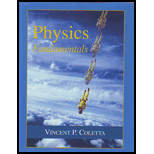
Concept explainers
(a)
The minimum possible value of
(a)
Explanation of Solution
Introduction:
(b)
Whether or not, there is any finite maximum value possible for
(b)
Explanation of Solution
Introduction:
Force of friction acts between two surfaces which are in relative motion or tend to have relative motion. The force of friction arises due to the roughness of the surface. It depends on the normal force. The constant of proportionality is known as the coefficient of friction.
There is a possible maximum value of
Want to see more full solutions like this?
Chapter 5 Solutions
Physics Fundamentals
- In a potentiometer experiment balancing lengths for first cell and second cell are 2.5 m and 2 m respectively, when cells are E1 used separately. Hence is E2 (а) 0.8 (b) 1.0 (c) 1.1 (d) 1.25arrow_forwardProblem 2: Line XY was measured by four parties a, b, c, d. Each party has two measurements as follows: Trial B 91.21 91.27 D 91.20 91.18 91.26 A 1 2 91.25 91.19 91.22 Find the precision of each party and find out which has the highest precision. b. What is the most probable length of XY? a.arrow_forwardLine XY was measured by four parties A, B, C, D. Each party has two measurements as follows: Trial A B C D 1 91.25 91.21 91.20 91.18 2 91.19 91.27 91.22 91.26 a. Find the precision of each party and which has the highest precision. b. What is the most probable length of XY?arrow_forward
- In a potentiometer experiment balancing lengths for first cell and second cell are 2.5 m and 2 m respectively, when cells are E₁ used separately. Hence is E₂ (a) 0.8 (b) 1.0 (c) 1.1 (d) 1.25arrow_forwardA rectangular piece of aluminum is 7.60 ± 0.01 cm longand 1.90 ± 0.01 cm wide. Verify that the fractional uncertainty in the area is equal to the sum of the fractional uncertainties in the length and in the width.arrow_forwardCheck Your Understanding If a=3+4i , what is the product a* a?arrow_forward
- why (8Bz)j is neglected in third pic when equating in the coefficient in k.arrow_forwardAssuming the dioder to be ideal is the figure for the output to be clipped, the simput voltag Vp must be outside the range. Vr (₂) AAAA toks Page ENV ✔ D₂A -2V + t loke V. ↓arrow_forward1. A student measures values 9.83 m/s?, 9.79 m/s?, 9.85 m/s?, 9.65 m/s?, 9.86 m/s2 and 9.77 m/s2 for g. Given that the "book" value of g is 9.80m/s?, (a) Find the average experimental value of g, with its associated uncertainty (b) Calculate % uncertainty for g (c) Calculate % error for g. (d) Which of the previous answers (b or c) determines the accuracy of the measured value? (e) Which of the previous answers (c or d) determines the precision of the measured value? (f) Is the experimental value compatible with the accepted value?arrow_forward
- The velocity of a neutron is measured to be 6.0 x 106 m s-1 with an uncertainty of 1.0 × 103 m s-1. (i) What is the minimum uncertainty of the simultaneous measurement of the position of the neutron? (ii) State how the minimum uncertainties of a measured energy and a measured time are relatedarrow_forwardcalculate dw dz if z= et* and w= Sin (t-2) |arrow_forwardThe propagation of uncertainty formula for the equation y - ax^2 is y (Ay +(Ay,)² where Aya = (ax²) – ((a + Sa)x²).and .Ayx = (ax?) - (a(x+ 5x)²) and. The values %3D %3D Sa and 5x are the uncertainties on a and x respectively. If a = 0.4 +/- 0.8 and x = -1.6+/-0.7 then what is the uncertainty on y?arrow_forward
 University Physics Volume 3PhysicsISBN:9781938168185Author:William Moebs, Jeff SannyPublisher:OpenStax
University Physics Volume 3PhysicsISBN:9781938168185Author:William Moebs, Jeff SannyPublisher:OpenStax
